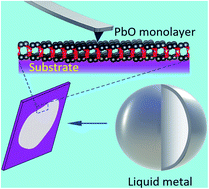Ultra-thin lead oxide piezoelectric layers for reduced environmental contamination using a liquid metal-based process†
Abstract
Mitigation of the health hazards and environmental pollution caused by Pb is necessary. However, piezoelectric Pb containing compounds, such as PZT, are still widely used in many industries and health sectors. One approach to reduce the hazards and contamination caused by Pb is to decrease the amount of this element in the devices by size reduction. In this regard, the possibility of using ultra-thin piezoelectric PbO films should be investigated. However, to date, the development of such two-dimensional (2D) PbO films, in large lateral dimensions, has faced certain challenges. Here a liquid metal-based 2D printing technique is employed to produce unit-cell thick PbO sheets by harvesting the interfacial oxide layer of liquid Pb. The resulting PbO monolayer, with lateral dimensions of hundreds of microns, exhibits an orthorhombic crystal phase with a wide direct band gap of 3.3 eV, larger than that of its bulk counterpart. In addition, remarkable vertical piezoelectric coefficients of ∼30 pm V−1 were obtained in unit-cell thick PbO through both measurements and density functional theory calculations. The PbO monolayers can be employed as an environmentally friendly alternative to PZT, in many commercial applications, due to the low content of Pb.



 Please wait while we load your content...
Please wait while we load your content...